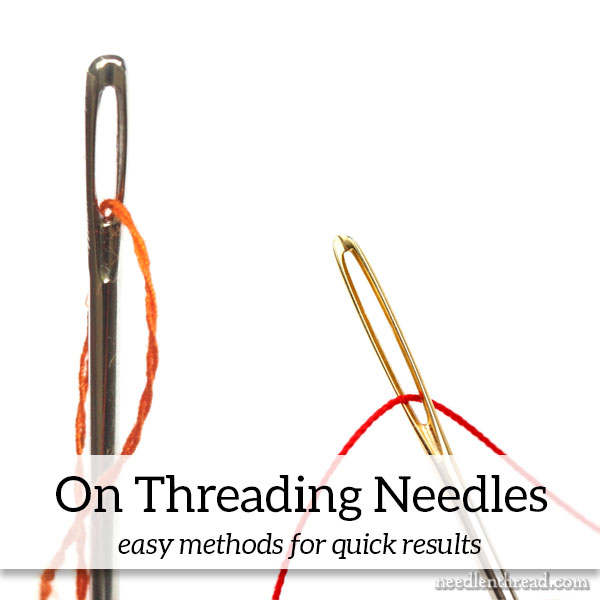I’m pretty sure Shakespeare’s soliloquy could be re-written for the embroiderer: To lick, or not lick, that is the question… but I won’t bother!
Whether you thread your needle by licking your thread or not, at least you ARE threading a needle!
But in case you didn’t know that there are (easy) options for threading a needle – other than licking your embroidery floss – I thought I’d present a couple tips on how to thread an embroidery needle without wetting your thread.
Thread Size and Needle Size
The first thing to consider when getting ready to thread your needle is the size of your thread and your choice of needle. If a needle is too small for the thread you’re using, it’s going to be much more difficult to thread!
Needle and thread size should correspond. You don’t want to use a needle that’s too BIG for your thread, as it will leave visible holes in your ground fabric. On the other hand, you don’t want to use a needle that’s too SMALL for your thread, either – you’ll cause yourself undue difficulty in stitching, having to tug with effort to get the needle and thread through the fabric, and you’ll wear out your thread more quickly.
After doing a bit of needlework, you’ll probably get the hang
of what’s right and what’s not for your needle and thread. An
easy rule of thumb is that the thickness of your needle should
match the thickness of the thread. If that’s still not doing it
for you, go slightly larger rather than slightly smaller.
The Other Side of the Needle’s Eye
Before getting into specific methods of threading a needle, here’s a point to consider with practically every machine-made needle out there:
One side of the eye of a needle is slightly larger, access-wise, than the other. This is because the eyes of needles are punched by a machine, and the side that gets the bulk of the punch is usually more open than the other side.
If you have difficulty threading a particular needle, try
turning the needle to access the other side of the eye.
Methods of Threading a Needle
If you lick your thread, I’m not one to say “Oh shame on you, you thread-licker, you!” I sometimes lick (as in barely moisten) my thread, too. But generally, I don’t.
There are four ways I thread my needle:
1. The Fold-and-Pinch Method: Margaret mentioned this in the comment on one of my needle reviews this week. (I reviewed Pony brand needles and hand-made Japanese needles earlier.)
You take your thread and fold it around the shaft of your needle. Slide it off, pinch the fold, and stick it in the eye. Pull it through so that the folded over part is all the way through, then situate the length of the tail however you like it. You might have to hold the pinched fold close between your finger and thumb and lay the eye on the folded thread and gently “saw” the needle down onto the thread. This method works great with size 10 and larger needles. It also works with size 11, depending on the thread you’re using. It’s a bit tough with #11 with one strand of DMC, but it works fine with one strand of YLI stranded silk.
2. The Pinch-and-Saw Method: For needles smaller than #10, snip the very end of your embroidery floss or thread so that it isn’t puffy and frayed. A clean cut is necessary for this method. Pull the thread between your thumb and forefinger, so that the tip of the thread is barely visible between the two. Lay the eye of your needle up on the tip of the thread, and, using a gently sawing motion, move the needle down between the skin of your thumb and forefinger. You will “saw” the thread into the eye of your needle.
3. The Gotta-Have-Help Method: Get a fine needlethreader and use it. There are many brands available – you can find them in the needlework section of most hobby, craft, and sewing places. But if you can, invest in a fairly good one. They aren’t expensive. Clover makes one that has a longer wire, and has two sizes, one on each end. The little tin ones you commonly see in multipacks don’t seem to last long for me. I’ve got a Clover one, and I’ve also got two extra-fine threaders that I found at a little shop. They have larger plastic tabs on the end, and one has a thread cutter set into the tab. They also have tiny magnets on the back. They both work great.
4. The If-All-Else-Fails Method: (Well… what can I say?) Lick the tip of your thread. But barely. You don’t have to saturate it! I’m pretty sure the children I teach in the summer work their saliva glands into Mass Production Mode just for the joy of soaking the ends of their threads. No, no! This isn’t necessary. If you must do this, then the tiniest bit of barely moist contact will do the job. Major water run-off is not at all necessary or desirable!
My reasons for not licking thread are mentioned in my review of Pony brand needles. But… if you have to, you have to. I think if you practice with the first two methods, you’ll find that you don’t have to rely on the last two that much!
So, grab a needle and thread and practice dry threading! You’ll be the envy of thread-lickers world wide!
